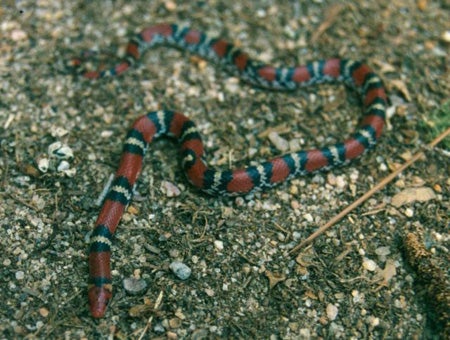SCIENTIFIC NAME:
Cemophora coccinea copei
STATUS:
Fairly common statewide. Thought to be declining throughout much of its distribution. Low Conservation Concern.
DESCRIPTION:
Scarlet snakes belong to the Class Reptilia, Order Squamata, Family Colubridae, Genus Cemophora, Species Coccinea, and Subspecies copei. Scarlet snakes are non venomous and usually 14-20 inches in length.
Is is one of three tri-colored snakes found in Alabama. They are very similar in appearance to the scarlet king snake. Both snakes are brilliantly colored with red, yellow, and black bands. Scarlet snakes, like scarlet king snakes have red bands that do not contact yellow bands.
Scarlet snakes can be distinguished from scarlet king snakes (Lampropeltis triangulum elapsoides) in that scarlet snakes’ bands do not encircle their entire body as do the bands of scarlet king snakes. Scarlet snakes’ bellies are solid white, gray, or pink. Their heads are red and their snouts are pointed. Their red bands are wider than are their black and yellow bands. Their scales are smooth in 19 rows, and the anal plate is single, not split.
DISTRIBUTION:
Scarlet snakes are found in the coastal regions of the southeastern United States, from the pine barrens of New Jersey south to Florida and west to Oklahoma. A subspecies of the scarlet snake occurs in peninsular Florida and is referred to as the Florida scarlet snake (Cemophora coccinea coccinea). In Alabama, scarlet snakes are found statewide except the mountainous regions of the northeastern part of the state. They are scattered and uncommon in the Piedmont region, and are most common in the Coastal Plain and Sandhills.
HABITAT:
Scarlet snakes are found in forested habitats having dry sandy soils. They are terrestrial burrowers, typically found under rocks, rotten logs, leaf litter, or debris such as roofing tin, boards, or trash. They often are found in suburban areas located with areas of suitable habitat.
FEEDING HABITS:
Scarlet snakes primarily feed on the eggs of other snakes and lizards. They have enlarged teeth which they use to open eggs that are too large for them to swallow whole. Scarlet snakes also consume small frogs, snakes, and lizards. Scarlet snakes are nocturnal, active and feeding mostly at night.
LIFE HISTORY AND ECOLOGY:
Little is known about the life history of scarlet snakes, but they are believed to lay two to nine eggs in the early summer. When the young emerge from their eggs they look like tiny versions of adult snakes. Scarlet snakes, like scarlet king snakes, often are mistakenly confused with venomous coral snakes (Micrurus fulvius).
They can be distinguished from coral snakes by application of information contained in the following rhyme: “Red touches black, venom lack; red touches yellow, kills a fellow”. The rhyme refers to the order of the colored rings that occur on the snakes. Learning to correctly identify the three similar snake species is the best way to stay safe. When in doubt, leave the snake alone.
REFERENCES:
Snakes of Georgia and South Carolina
https://srelherp.uga.edu/snakes/scarlet-snake/
Cemophora coccinea; Scarlet Snake
http://www.flmnh.ufl.edu/herpetology/FL-GUIDE/Cemophoracoccinea.htm
AUTHOR:
James Altiere, Wildlife Biologist, Alabama Division of Wildlife and Freshwater Fisheries






